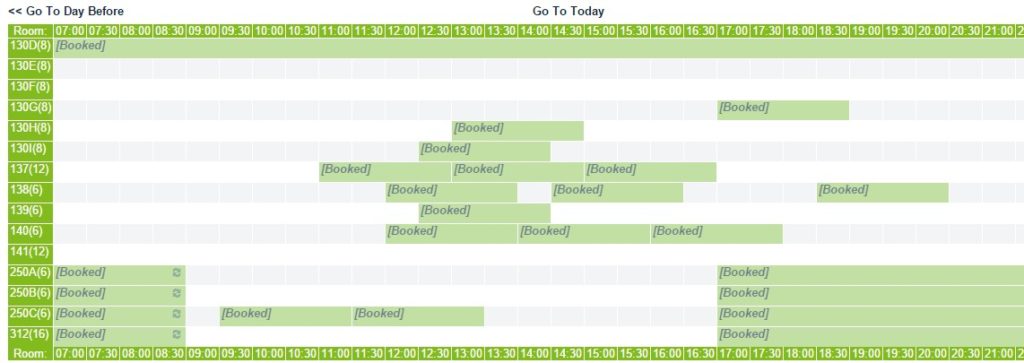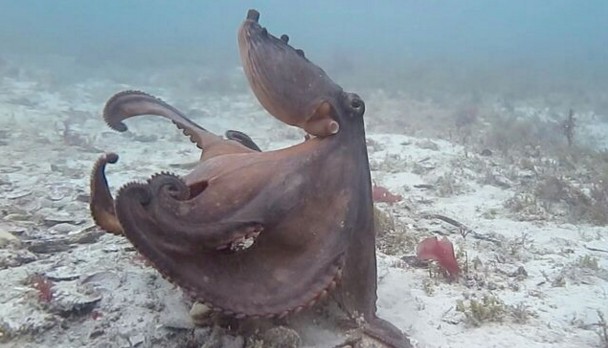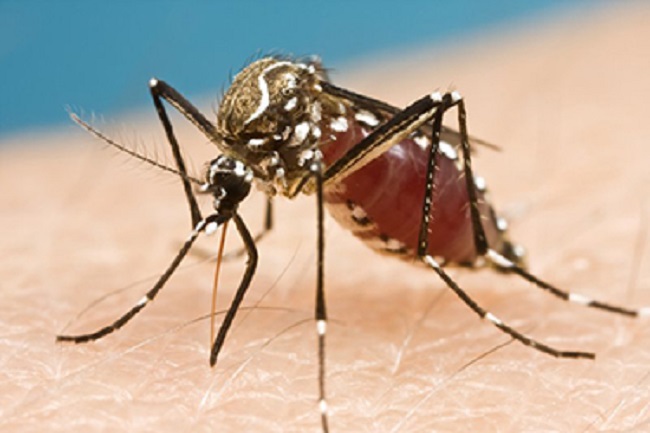The My French Film Festival has been running for six years. It features movies in and out of competition, with juries, awards, and screenings in theatres and online. We take a look at the festival itself and about what it means for cinema in general.
Octopuses Turn Black, Posture Aggressively To Intimidate Each Other
A recent study of octopuses off the coast of Australia has discovered that — despite usually being considered a solitary animal — octopuses have a social life, and part of that social life involves physical displays of toughness.
When octopuses meet each other in agonistic interactions, they exhibit certain types of behavior, researchers at the Alaska Pacific University found.
“We found that octopuses are using body patterns and postures to signal to each other during disputes,” said David Scheel of Alaska Pacific University.
“The postures and patterns can be quite flashy, such as standing very tall, raising the body mantle high above the eyes, and turning very dark.”
The impetus for the research came from a member of an online cephalopod community noting something he’d seen octopuses doing that he thought was interesting. The researchers took it from there, watching 186 interactions between Octopus tetricus — a species that lives in Jervis Bay, Australia — which furnished them with 500 interactions.
The agonistic behavior was what they noticed primarily.
When both octopuses turned black, it was more likely they would engage in physical violence to settle the question of dominance, but when one turned black and the other was a pale color, the pale colored octopus more often retreated while the black octopus held the field.
“Dark color appears to be associated with aggression, while paler colors accompany retreat,” said Scheel.
Next for the researchers is further investigation of octopus interactions — specifically, they want to investigate suspicions that social interactions among the species occur when food is abundant and hiding places scarce. They also want to understand the consequences of these types of social interactions in the context of octopus populations.
The report, “Signal Use by Octopuses in Agonistic Interactions,” was completed by Drs. David Scheel, Peter Godfrey-Smith and Matthew Lawrence, and was published in the journal Current Biology.
By Andy Stern
Iceland’s Pirate Party Increases Election Poll Lead
This article has moved to our new website: Iceland’s Pirate Party Increases Election Poll Lead
America Has The Right Type Of Mosquito For The Zika Virus – Yale Epidemiologist
The Zika virus, which has caused a surge in infant birth defects in Latin America and the Caribbean in recent years, and which has now spread to the U.S., is carried by a type of mosquito common in the Southern states, according to Dr. Albert Icksang Ko, an epidemiologist at Yale.
“The mosquito vector for Zika is genus Aedes mosquitos, of which Aedes aegypti as well as Aedes albopictus is found to infest regions of North America, such as Mexico and southern U.S,” Ko, Professor of Epidemiology and Medicine at Yale, told The Speaker.
Ko, whose work focuses on the health problems which have emerged as a consequence of rapid urbanization and social inequity, commented on the possible future of the virus:
“This is a potentially serious public health threat since it can be transmitted rapidly to regions where the mosquito vector is in sufficient abundance and because of the risk it poses to causing birth defects in newborns whose mothers were infected during pregnancy.”
The as-yet untreatable virus has been found in a half-dozen cases in the U.S. over the past two weeks. In all cases the mother had recently travelled to a Latin American or Caribbean country.
A U.S. travel warning is currently in effect advising pregnant women to avoid travel from 22 countries in which the Zika virus is common.
Ko told us that human biological responses to the virus — such as immunity in already-affected areas — are not yet understood. “We presume that after an immunocompetent individual is infected with zika virus they will develop lifelong immunity shortly after infection as with other flavirus infectionsm but we don’t have direct evidence at this point.”
The Zika virus has been known since 1947 when it was identified in Uganda. The virus was initially found in a rhesus monkey during yellow fever research. Seven years later, in 1954, the virus was discovered in a human in Nigeria. Cases were rare until 2007 when larger outbreaks began in several Pacific Island nations.
TD Bank Raises Fees
Canada’s TD Bank has raised fees in several areas this year, including significant charges for things that were free before.
The cost to withdraw cash from non-TD Bank ATMS has risen 50 cents to $2.00, but perhaps most significant are the completely new fees:
Interac e-Transfers, which were a free service with TD Bank, now cost $5 each. It will also cost $5 to deposit a post-dated check, which was free before.
Also, TD Bank’s tax-free savings accounts previously allowed free transfers to other banks. Now those transfers will cost $75 plus tax.
The bank has also added insufficient funds fees, whereas before such fees were not applicable.
The changes will take effect March 1, according to a TD Bank customer email sent out this week.
By Andy Stern
Venus Flytraps: Scientists Discover How They Work
An accumulation of action potentials is behind Venus Flytraps’ “decision” to keep closed and start producing digestive enzymes once their trap sensors are triggered, scientists at Universität Würzburg have found.
“The carnivorous plant Dionaea muscipula, also known as Venus flytrap, can count how often it has been touched by an insect visiting its capture organ in order to trap and consume the animal prey,” said Rainer Hedrich of Universität Würzburg in Germany.
The researchers wanted to understand how Venus Fly traps decide to close and how they decide they have something to digest. After all, the researchers noted, closing their traps around an object and filling with digestive enzymes is biologically costly, and sometimes their sensors are triggered by stimuli that are not prey at all — “false alarms.”
The researchers sought to test this by implanting artificial sensors in a Venus Flytrap. The sensors are thin spikes that stick out of the inside of the plant’s interior walls. They then flicked the sensors to cause the plant to close. When the scientists continually flicked the sensors, the plant became excited and began to produce the acidic digestive bath that fills their closed lobes.
By means of accumulated action potentials, the plant understands that what it has caught is in fact a struggling insect. It also understands the size of the insect by the number of the sensors it triggers.
“The number of action potentials informs [the plant] about the size and nutrient content of the struggling prey,” Hedrich said. “This allows the Venus flytrap to balance the cost and benefit of hunting.”
To eat, the scientists concluded, a Venus Flytrap requires at least five contacts with its sensors. The second trigger closes the plant, the third and further triggers activate touch hormones and begin the production of digestive enzymes, and the fifth begins the uptake of nutrients.
The report, “The Venus Flytrap Dionaea muscipula Counts Prey-Induced Action Potentials to Induce Sodium Uptake,” was completed by Böhm and Scherzer et al, and was published in the journal Current Biology.
By Andy Stern
Chinese Vancouverite Aided Chinese Military In Theft Of F-35 Blueprints, Report Claims
The Globe and Mail has caused a court “book of record” to be released from the Vancouver court in which a trial against a Chinese Vancouverite accused of spying for China is taking place. The most recent development: Two unnamed co-conspirators in the case have been found to be Chinese soldiers.
Allegedly, Su Bin, a 50-year old entrepreneur living in Vancouver, helped the Chinese cyper-spying operation steal American fighter jet plans by providing focus for the hacking efforts of the Chinese soldiers. This help was documented in intercepted emails, according to the court documents.
In the trial, based on a U.S. charge, the two Chinese soldiers were referred to only as “unindicted co-conspirators” “affiliated with mulitiple organizations and entities.” No mention was made that they were tied to the Chinese army.
The Globe and Mail-obtained court documents show that the two had been explicitly referred to as “two Chinese military officers.” The two Chinese soldiers have also been identified by U.S. authories, according to the documents, although the names are not revealed by the Globe-obtained documents.
By Devon James
Read more: Chinese soldiers implicated in U.S. military hacking case
If-Modified-Since Explained
What Is If-Modified-Since? … If-Modified-Since (aka “the If-Modified-Since HTTP header”) explained.
(This is an SEO-relevant question asked by web developers who want search engines to understand and rank their webpages.)
“304 status code” or no “304”?
Every so often, the Googlebot spider will visit your website. If you have updated your page since last time it was there, you will want the spider to re-index the page, not just pass it over and think the same material is there as last time.
It takes a lot of time and energy to crawl through an entire website and index all those pages. Googlebot wants you to tell it if you have changed each page or if there is no change.
304 is a signal by which a web page tells a crawler that it has not changed. If there is no 304 signal, the crawler will crawl the page and see what is there.
So you put an “If-Modified-Since HTTP header” on each page. If the page has modified since last time, re-index it, please, you are saying to the spider. If the page has not changed, you can keep your old records in the Google Seach Engine.
How to do the If-Modified-Since header:
– Use the If-Modified-Since Tool (… not right now thought. This tool is down.)
– Communicate with your server. Ask them, “Does my web server (the server on which my sites are hosted) support the If Modified Since header?
– You can also install a plugin that does adds the If-Modified-Since HTTP header to your website. Some of these are buggy or not updated, but at least (as long as it works) you can activate it, then run a test to check (HTTP Header Checker by ForBrains.co.uk) if it’s doing “Last-Modified”, and if it is, you can see If-Modified-Since is supported. (However, you may want to code your own code for If-Modified-Since for your website and avoid a plugin, because plugins can cause problems and slow down websites.)
Fracking Operation Ordered To Shut Down After Earthquake
A Repsol fracking operation was ordered to shut down this week after an earthquake shook the region around Fox Creek, Alberta.
The earthquake measured 4.8 on the Richter scale — large enough to rattle pictures handing on walls, according to Fox Creek mayor Jim Ahn, who reported that he thought a truck had rolled by his building when the 1.5-second earthquake took place.
That was enough, though, for Alberta Energy Regulator to shut down the Repsol Oil & Gas site 35 kilometers north of the town.

The province’s energy regulator shuts down any fracking site when there is an earthquake of 4.0 or greater magnitude in the area.
Scientists will now investigate whether fracking was the cause of the earthquake. If confirmed to be the cause, the quake would be the largest found to be caused by fracking in Canada.
Currently, the largest fracking-caused earthquake in Canada is a 4.6 magnitude quake that took place in northeastern B.C. last summer.
By Andy Stern
BC University Is Giving Students A Nap Room
BCIT is providing a power-nap room, hoping to allow some of their students — already sleeping in other parts of the school — to boost their energy levels.
The sleep room, launched Monday, is available to book for hour periods between 12:30 and 5 p.m. four days per week — Monday, Tuesday, Thursday and Friday. Students can check bed availability at any time on the university’s online portal.
There are 10 beds in the low-lit room — which is also a racquetball court — and a station where students can pick up clean pillow cases and sanitizer. Students are required to spray and wipe the vinyl beds after use.
The nap room has a set of rules provided by the BCIT Student Association. Cell phone noise and talking is prohibited in the nap room and beds are not allowed to be pushed together.
The room was initiated after BCIT authorities noticed students sleeping all over the campus and realized that their students must be very tired. In addition to the benefits of alertness during classes, the school also hopes to cut down on driving accidents. Many BCIT students commute to the university from significant distances.

The new nap room will be available to students for one booking per week “to start,” according to the BCITSA, and they have plans to eventually allow one booking per day.
BICTSA
Photos: BCITSA
Watch A Visual Representation Of The Earth Rotating In Space
This javascript-based visual representation of the Earth spinning in space was developed and shared on the website CodePen by programmer Eric J Nesser.
Holding down the mouse left-click button while scrolling will zoom or change the viewing angle of the representation of the Earth.
See the Pen Earth WebGL Demo by Eric J Nesser (@enesser) on CodePen.















